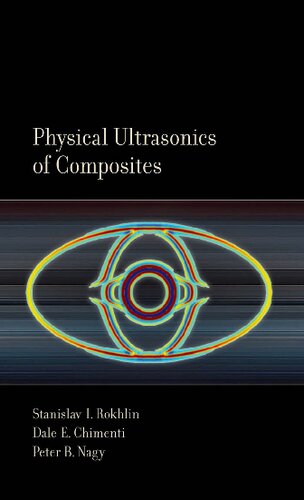

Most ebook files are in PDF format, so you can easily read them using various software such as Foxit Reader or directly on the Google Chrome browser.
Some ebook files are released by publishers in other formats such as .awz, .mobi, .epub, .fb2, etc. You may need to install specific software to read these formats on mobile/PC, such as Calibre.
Please read the tutorial at this link: https://ebookbell.com/faq
We offer FREE conversion to the popular formats you request; however, this may take some time. Therefore, right after payment, please email us, and we will try to provide the service as quickly as possible.
For some exceptional file formats or broken links (if any), please refrain from opening any disputes. Instead, email us first, and we will try to assist within a maximum of 6 hours.
EbookBell Team

4.1
60 reviewsPhysical Ultrasonics of Composites is a rigorous introduction to the characterization of composite materials by means of ultrasonic waves. Composites are treated here not simply as uniform media, but as inhomogeneous layered anisotropic media with internal structure characteristic of composite laminates. The objective here is to concentrate on exposing the singular behavior of ultrasonic waves as they interact with layered, anisotropic materials, materials which incorporate those structural elements typical of composite laminates.
This book provides a synergistic description of both modeling and experimental methods in addressing wave propagation phenomena and composite property measurements. After a brief review of basic composite mechanics, a thorough treatment of ultrasonics in anisotropic media is presented, along with composite characterization methods. The interaction of ultrasonic waves at interfaces of anisotropic materials is discussed, as are guided waves in composite plates and rods. Waves in layered media are developed from the standpoint of the "Stiffness Matrix," a major advance over the conventional, potentially unstable Transfer Matrix approach. Laminated plates are treated both with the stiffness matrix and using Floquet analysis. The important influence on the received electronic signals in ultrasonic materials characterization from transducer geometry and placement are carefully exposed in a dedicated chapter. Ultrasonic wave interactions are especially susceptible to such influences because ultrasonic transducers are seldom more than a dozen or so wavelengths in diameter. The book ends with a chapter devoted to the emerging field of air-coupled ultrasonics. This new technology has come of age with the development of purpose-built transducers and electronics and is finding ever wider applications, particularly in the characterization of composite laminates.